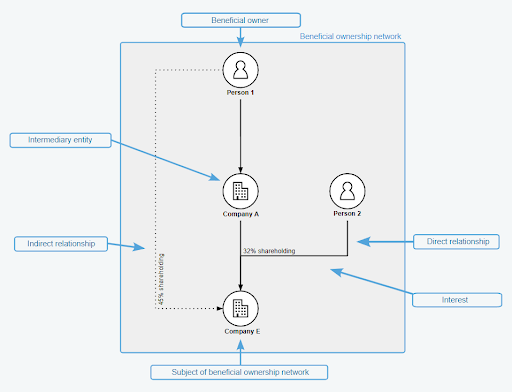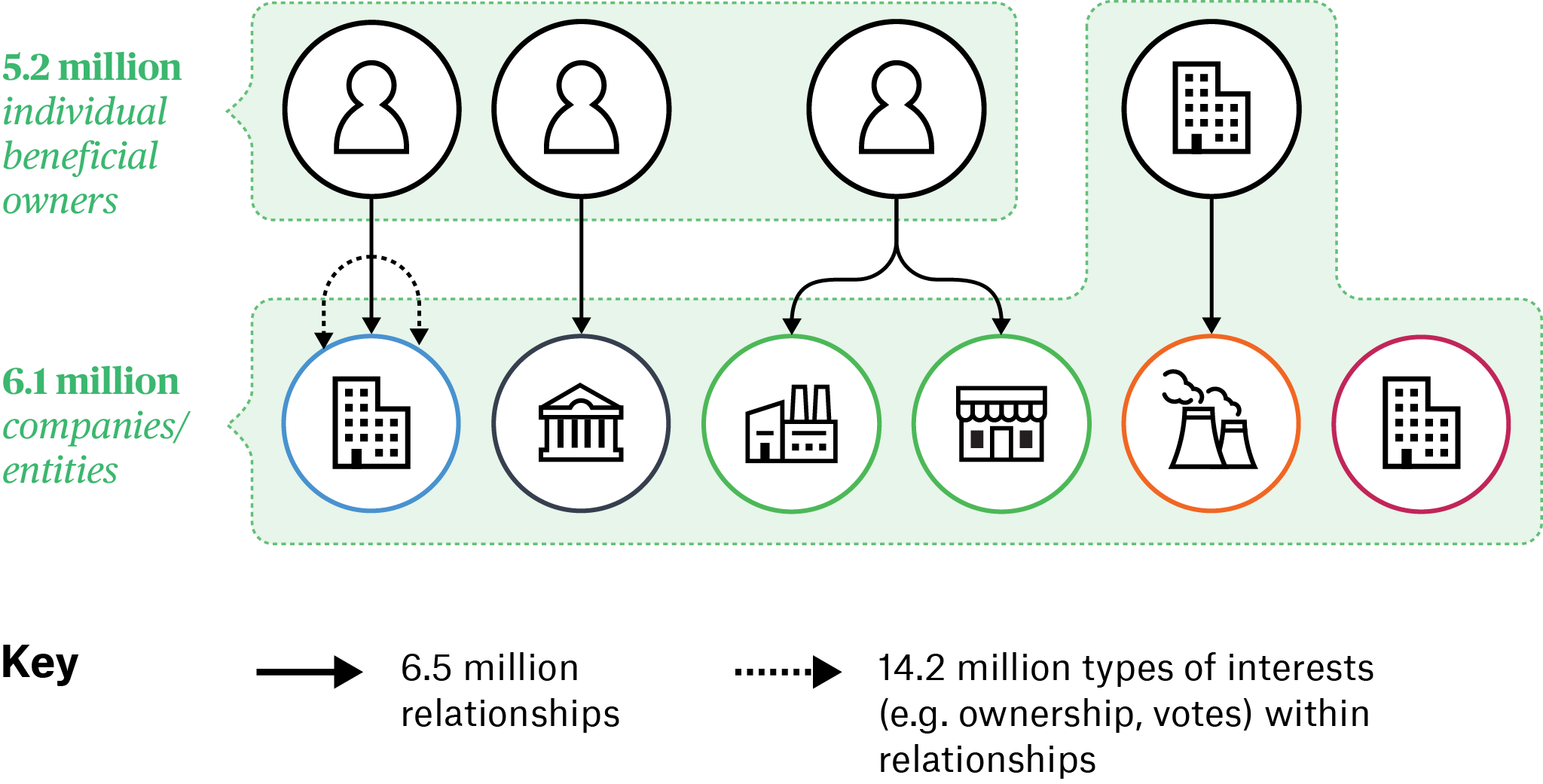Insights from the United Kingdom’s People with Significant Control register
3. Methodology
3.1 Terminology
To ensure clarity, this research adopts consistent terms for key elements in BO information (Figure 1): [15]
- Individual beneficial owner: An individual who ultimately owns, controls, or benefits from an entity. Also referred to as an ultimate beneficial owner. [16]
- Intermediary entity: An entity registered as a corporate beneficial owner. In the UK, a (UK-based) entity may be listed as a beneficial owner if it is registered with Companies House and its own beneficial owners are disclosed. For example, if Company A is owned by (UK-based) Entity 1, and Entity 1 is owned by Sophia, only Entity 1 is listed as the beneficial owner of Company A, while Sophia appears as the beneficial owner in Entity 1’s records.
- Entity: A legal vehicle that may be owned by individuals and/or corporate beneficial owners. This includes companies, trusts, foundations, or limited liability partnerships.
- Relationship: A direct or indirect connection through which ownership, control, or benefit is conferred.
- Interest: The nature of the connection between an owner and an entity, which may include shareholding, voting rights, board appointments, rights to surplus assets on dissolution, or other forms of influence or control. In the UK register, shareholding and voting rights are disclosed in percentage ranges (e.g. 25–50%, 50–75%, and 75–100%) rather than as exact values.
Figure 1. Key components of beneficial ownership information

3.2 Data collection and processing
This research analyses BO data from the UK People with Significant Control (PSC) register, using the republished and standardised version made available by Open Ownership as of 7 June 2024. [17] The PSC register, launched in April 2016, contains information on individuals and entities that hold significant control over companies registered with UK Companies House.
Open Ownership republishes this data in line with the Beneficial Ownership Data Standard (BODS), ensuring consistency with international best practices for structuring and processing BO information. [18] The dataset is further reconciled and enriched using bulk data from OpenCorporates, and it aligns with the terminology adopted in this study to support clarity and comparability. [19]
Structured according to the BODS schema, the dataset is organised into tables representing the three core elements of beneficial ownership: individuals, entities, and relationships. For analytical purposes, records linked to dissolved or inactive entities and ended relationships have been excluded. To enhance accuracy and eliminate duplication, individuals and entities are mapped to unique and consistent identifiers.
3.3 Analytical strategy
To address the research objectives of exploring policy reform, detecting outliers, and developing a structured approach, a two-stage analytical strategy was applied.
In the first stage, a comprehensive overview of the UK PSC register was conducted to quantify key components, including the number of beneficial owners, entities, and relationships. This stage also involved summarising key ownership characteristics across the dataset.
The second stage focused on segment-specific analysis, investigating patterns and anomalies across four targeted scenarios:
- Entities with no individual beneficial owners: This segment includes entities that do not list any individual beneficial owners. It comprises two groups: entities with no BO records at all (red entity in Figure 2); and entities that list intermediary legal entities as beneficial owners but do not disclose any individual beneficial owners (orange entity in Figure 2). Our analysis has estimated the number of such cases and examined anomalies within the second group, particularly those involving layered or complex ownership structures with multiple intermediary entities.
- Individual beneficial owners with multiple entity connections: This analysis explores individuals linked to more than one entity (e.g. an individual listed as a beneficial owner of two or more entities, as shown by the green entities in Figure 2). The focus is on identifying patterns of ownership concentration and detecting unusual cases of interconnected ownership networks. While some entities in this segment may have several beneficial owners, each case includes at least one individual who controls more than one entity.
- Individual beneficial owners with single entity connections: This segment focuses on individuals who are beneficial owners of only one entity. These individuals are further categorised into those with a single declared interest (e.g. individuals with exclusive shareholding, shown by the black entity in Figure 2) and those with multiple interests in the same entity (e.g. individuals holding both shareholding and voting rights represented by the blue entity in Figure 2). [20]
- Entities with at least one individual beneficial owner holding multiple interests: In this segment (e.g. the blue entity in Figure 2), we calculate the number of individual beneficial owners who hold more than one type of interest in a single entity and identify cases that suggest unusually high concentration of ownership and control. The analysis also examines entities with two beneficial owners, assessing whether their interests are balanced (e.g. equal 50% shares) or uneven, potentially indicating symbolic ownership (e.g. 99% vs. 1%).
Figure 2. Visualisation of the UK PSC information

3.4 Limitations
Analysing BO data is challenging due to its complexity and the limitations of data collection. One major constraint is the absence of structured legal ownership data. For instance, if Sofia owns Entity A, which in turn owns Entity B, treating Entity A and B as separate without recognising their relationship obscures the underlying ownership structure. A 2020 study by the Tax Justice Network attempted to address this by focusing on “target companies” that do not own other entities, distinguishing them from intermediaries. [21] However, this approach overlooks circular or layered structures and risks excluding legitimate businesses while missing shell or high-risk companies.
UK legislation further complicates the analysis. Intermediary entities registered with Companies House can be listed as corporate beneficial owners (entities) without disclosing their ultimate beneficial owners (individuals). For example, Entity B can name Entity A as its corporate beneficial owner if Entity A is registered with Companies House and lists Sofia as its beneficial owner. This practice makes it difficult to trace ultimate ownership, requiring additional steps to understand control and influence.
The presence of intermediary entities adds further complexity. Ownership chains often span multiple layers, where intermediary entities are owned by other entities, forming dense and opaque structures. Ideally, shareholder information would be structured and integrated with BO data, enabling analysts to reconstruct full ownership networks and assess control distribution. However, in the UK, shareholder data is unstructured and maintained separately from BO data, posing significant barriers to comprehensive analysis. [22]
Limitation in data formatting also hinders transparency. Shareholding and voting rights are reported in broad percentage bands (25–50%, 50–75%, and 75–100%) rather than exact figures, limiting the ability to precisely assess ownership stakes. There is growing advocacy for more granular data on ownership relationships, including exact percentages for shareholding and voting rights. [23]
Finally, data verification remains a critical issue. The UK PSC register does not currently verify the accuracy of reported information, leaving the data vulnerable to errors, inconsistencies, and outdated entries. Until Companies House fully implements its gatekeeper powers under the Economic Crime and Corporate Transparency Act 2023, the reliability of the register remains in question. [24] Robust verification mechanisms will be essential to ensuring the credibility and effectiveness of the register as a transparency and accountability tool. [25]
Footnotes
[15] For more information about key elements of BOT see: “Beneficial Ownership Data Standard v0.4 – Key concepts”, Open Ownership, n.d., https://standard.openownership.org/en/0.4.0/standard/concepts.html#beneficial-ownership-concepts.
[16] The FATF Glossary defines the beneficial owner of legal vehicles as “the natural person(s) who ultimately owns or controls a customer and/or the natural person on whose behalf a transaction is being conducted. It also includes those natural persons who exercise ultimate effective control over a legal person. Only a natural person can be an ultimate beneficial owner, and more than one natural person can be the ultimate beneficial owner of a given legal person”. See: FATF, The FATF Recommendations: International Standards on Combating Money Laundering and the Financing of Terrorism & Proliferation (FATF, updated 2025), 123, https://www.fatf-gafi.org/content/dam/fatf-gafi/recommendations/FATF%20Recommendations%202012.pdf.coredownload.inline.pdf.
[17] The version of the UK PSC data republished by Open Ownership can be downloaded at: “UK People with significant control (PSC) Register (2024-06-07)”, Open Ownership, Beneficial ownership data analysis tools, 2024, https://bods-data.openownership.org/source/UK_PSC/.
[18] “Beneficial Ownership Data Standard”, Open Ownership, n.d., https://www.openownership.org/en/topics/beneficial-ownership-data-standard/.
[19] Open Ownership believes that individuals using BO information to achieve stated policy aims, both inside and outside governments, should have access to sufficient information in order to meaningfully use the data.
[20] We differentiate these groups to avoid conflating distinct populations. For example, if Sofia owns Company A and has voting rights in Company B, it might incorrectly appear as though she holds both ownership and control over one entity. Without this separation, the data could become skewed, as beneficial owners linked to a single entity may exhibit different relationship patterns compared to those connected to multiple entities, who are often wealthier individuals or nominees.
[21] See: Knobel and Seabarron, “Exploring UK companies’ legal ownership chains”.
[22] More information can be found here: UK government, Companies House, “Guidance: Companies House data products”, updated 25 October 2022, https://www.gov.uk/guidance/companies-house-data-products.
[23] Open Ownership, “Detail”, in Open Ownership Principles for beneficial ownership disclosure (Open Ownership, updated 2023), https://www.openownership.org/en/principles/detail/.
[24] UK Parliament, Government bill, “Economic Crime and Corporate Transparency Act 2023”, Originated in the House of Commons, Session 2022-23, updated 28 February 2024, https://bills.parliament.uk/bills/3339.
[25] Open Ownership, “Verification”, in Open Ownership Principles for beneficial ownership disclosure (Open Ownership, updated 2023), https://www.openownership.org/en/principles/verification/.